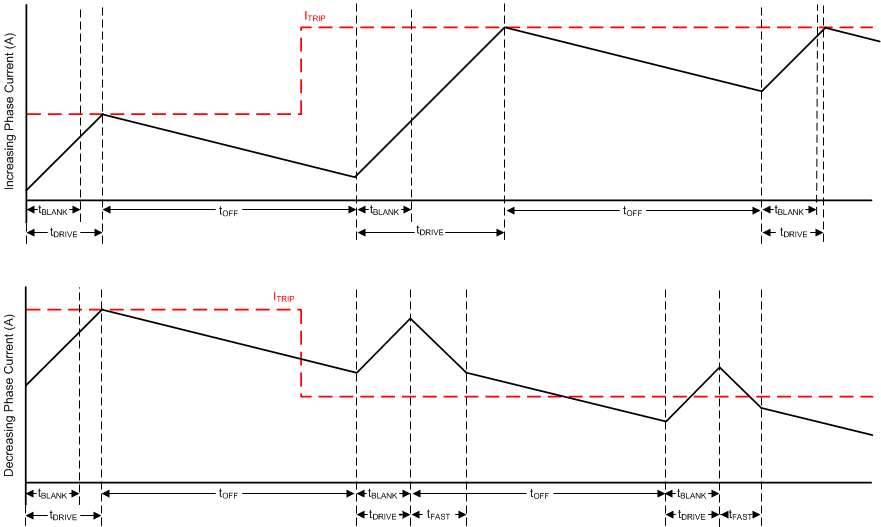SLVSGF5A May 2023 – December 2023 DRV8845
PRODUCTION DATA
- 1
- 1 Features
- 2 Applications
- 3 Description
- 4 Device Comparison
- 5 Pin Configuration and Functions
- 6 Specifications
-
7 Detailed Description
- 7.1 Overview
- 7.2 Functional Block Diagram
- 7.3 Feature Description
- 7.4 Device Functional Modes
- 8 Application and Implementation
- 9 Layout
- 10Revision History
- 11Mechanical, Packaging, and Orderable Information
Package Options
Mechanical Data (Package|Pins)
- RHH|36
Thermal pad, mechanical data (Package|Pins)
Orderable Information
7.3.5 Current Regulation and Decay Mode
During PWM current chopping, the H-bridge is enabled to drive through the motor winding until the chopping current threshold is reached. This is shown in Figure 7-5, Item 1.
Once the chopping current threshold is reached, the H-bridge can operate in two different states, fast decay or slow decay.
- In fast decay mode, as soon as the PWM chopping current level is reached, the H-bridge reverses state by switching on the opposite arm MOSFETs to allow the winding current to flow in the opposite direction. As the winding current approaches zero, the H-bridge is disabled to prevent further reverse current flow. Fast decay mode is shown in Figure 7-5, item 3.
- In slow decay mode, the winding current is re-circulated by enabling both low-side MOSFETs in the H-bridge. This is shown in Figure 7-5, Item 2.
 Figure 7-5 Decay Modes
Figure 7-5 Decay ModesThe DRV8845 features the smart tune Dynamic Decay mode for current control. The smart tune is an advanced current regulation scheme compared to traditional mixed decay modes. Smart tune helps the stepper motor driver adjust the decay scheme based on changes in operating factors such as:
- Motor winding resistance and inductance
- Motor aging
- Motor dynamic speed and load
- Motor supply voltage variation
- Motor back-EMF difference on rising and falling steps
- Step transitions
- Low-current versus high-current dI/dt
 Figure 7-6 Smart tune Dynamic Decay Mode
Figure 7-6 Smart tune Dynamic Decay ModeSmart tune Dynamic Decay dynamically adjusts the fast decay percentage of the total mixed decay time. This eliminates the need for motor decay tuning by automatically determining the best mixed decay setting that results in the lowest ripple and best performance for the motor.
The fast decay percentage is optimized iteratively each PWM cycle. If the motor current overshoots the target ITRIP level, then the mixed decay mode becomes more aggressive (by increasing fast decay percentage) on the next cycle to prevent loss of current regulation. If a long drive time must occur to reach the target ITRIP level, the decay mode becomes less aggressive (by reducing fast decay percentage) on the next cycle to operate with less ripple. On falling steps, smart tune Dynamic Decay automatically switches to fast decay to reach the next step quickly. Smart tune Dynamic Decay operates with fixed 16μs OFF time.